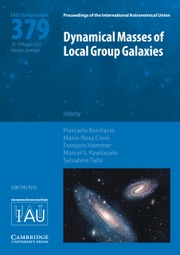No CrossRef data available.
Article contents
Late-Phase Observations of a Super-Chandrasekhar SN Ia
Published online by Cambridge University Press: 17 January 2013
Abstract
A super-Chandrasekhar (SC) supernova (SN) has an extremely high luminosity and a slow decline rate of the light curve in the early-phase. We present late-phase observations of the SC SN 2009dc. We find that the optical luminosity a year after maximum is much fainter than that expected from its early luminosity. We attempt to fit the analytic light curve model to the observations using Arnett's rule. The model successfully explains the light curves until 120 days. This suggests that the extremely high luminosity originates from the 56Ni decay. We suggest that the late-phase decline would be caused by dust formation. The existence of strong carbon features in early-phase spectra would support this scenario. We also find a blend of [Ca ii] and [Ni ii] in its late-phase spectrum. This indicates that the calcium is distributed in the inner layer along with nickel and iron. We conclude that the mixing may occur in the inner parts of the ejecta.
Keywords
- Type
- Contributed Papers
- Information
- Proceedings of the International Astronomical Union , Volume 7 , Issue S281: Binary Paths to Type Ia Supernovae Explosions , July 2011 , pp. 319 - 321
- Copyright
- Copyright © International Astronomical Union 2013




